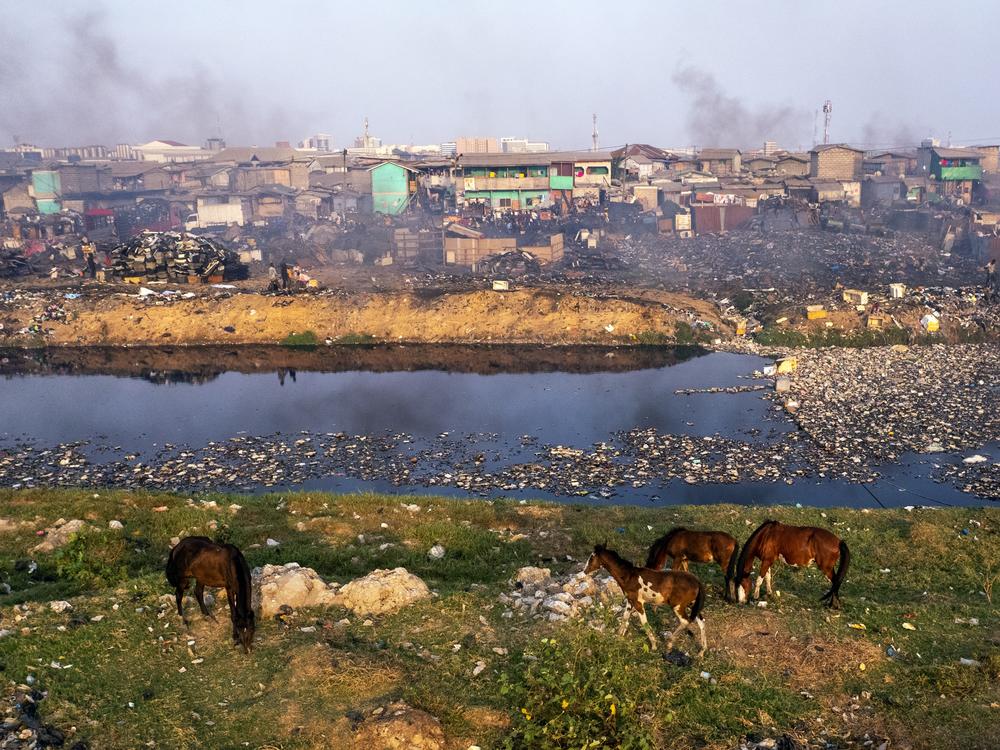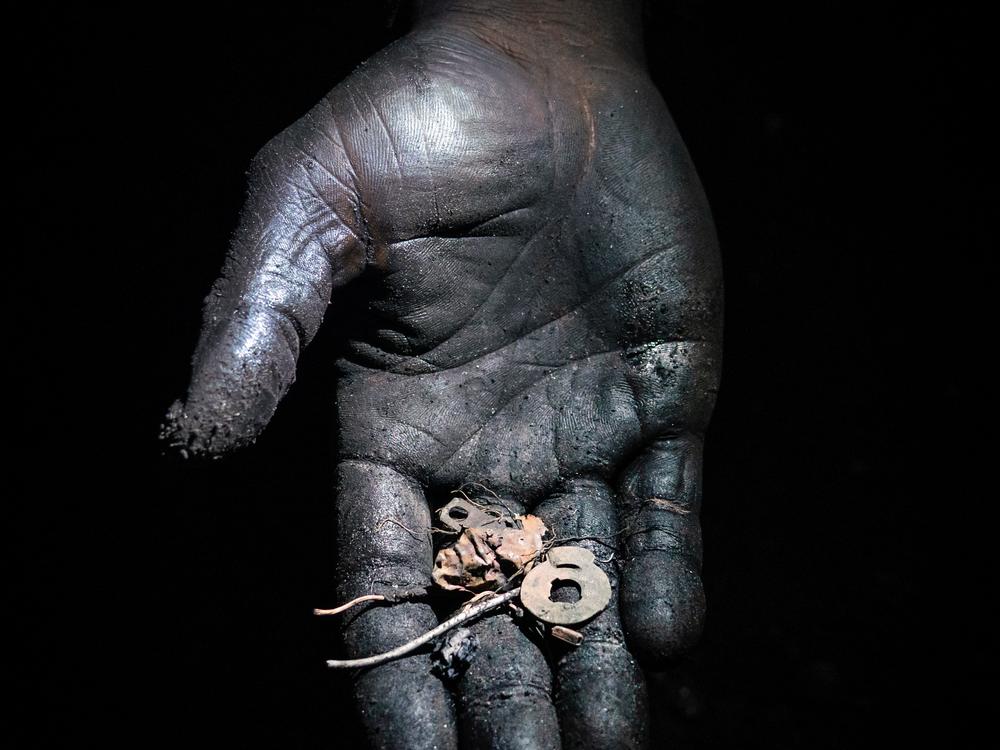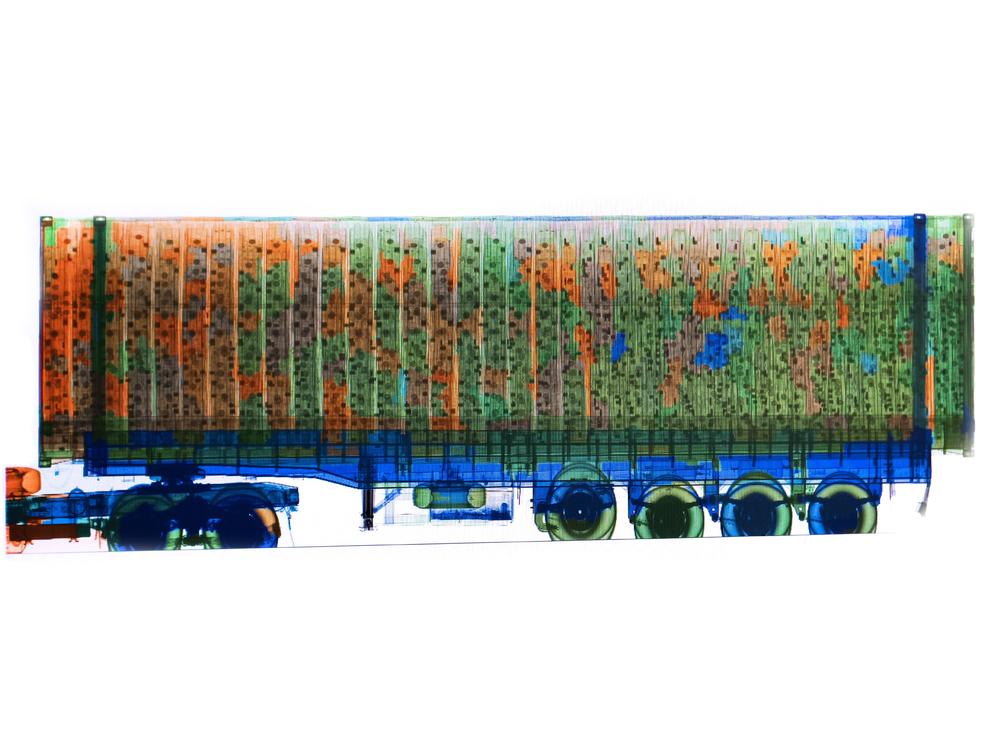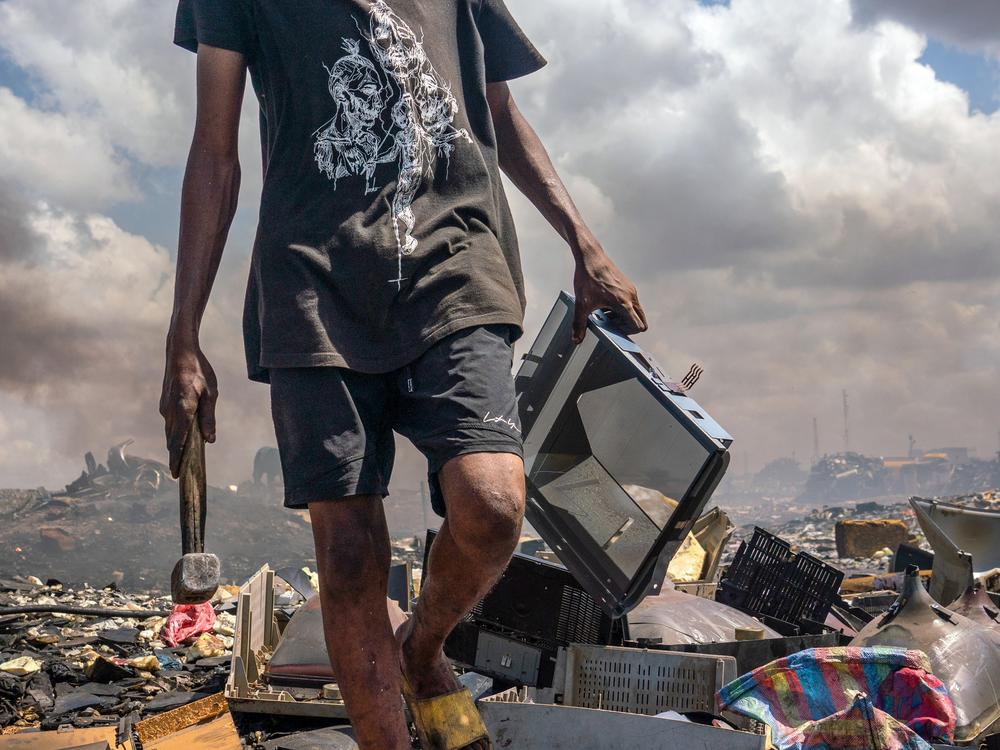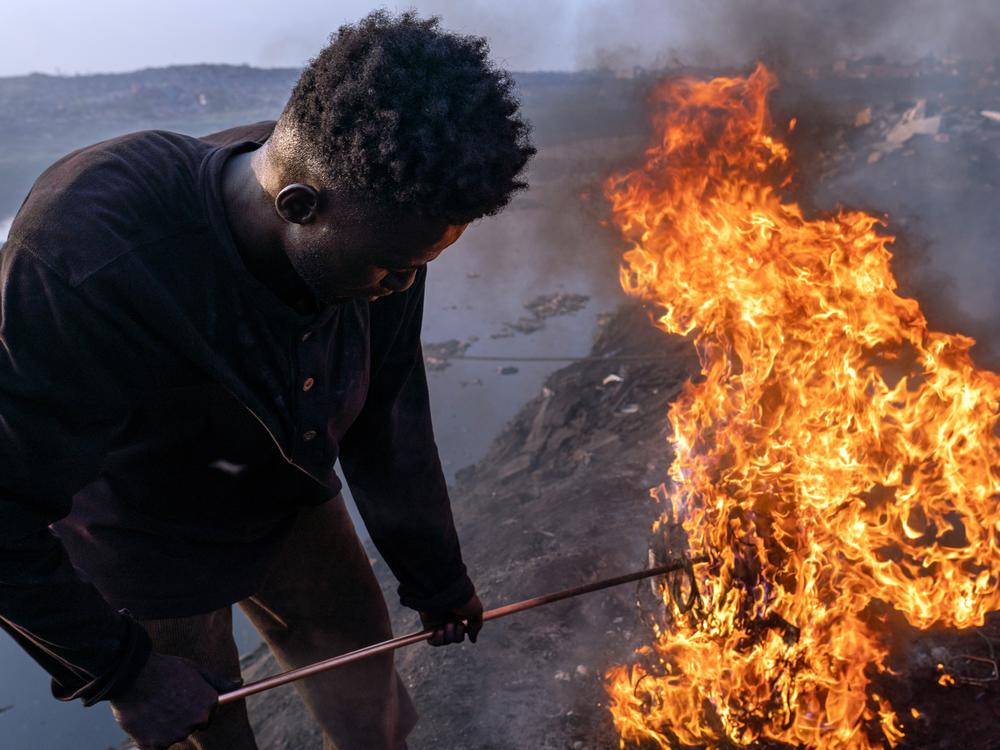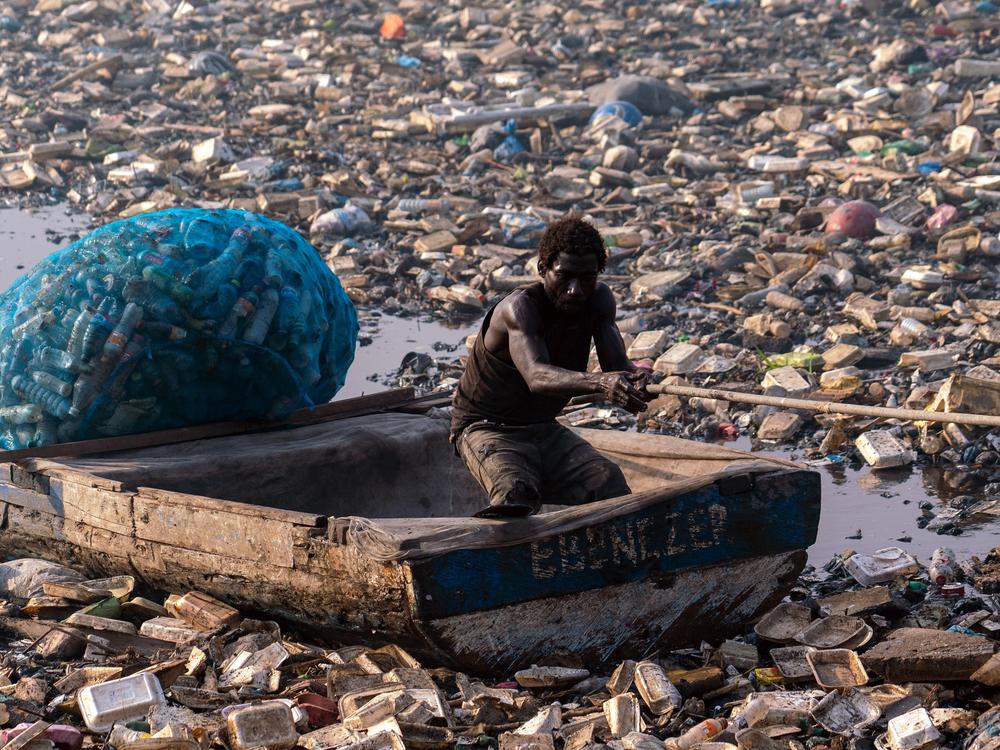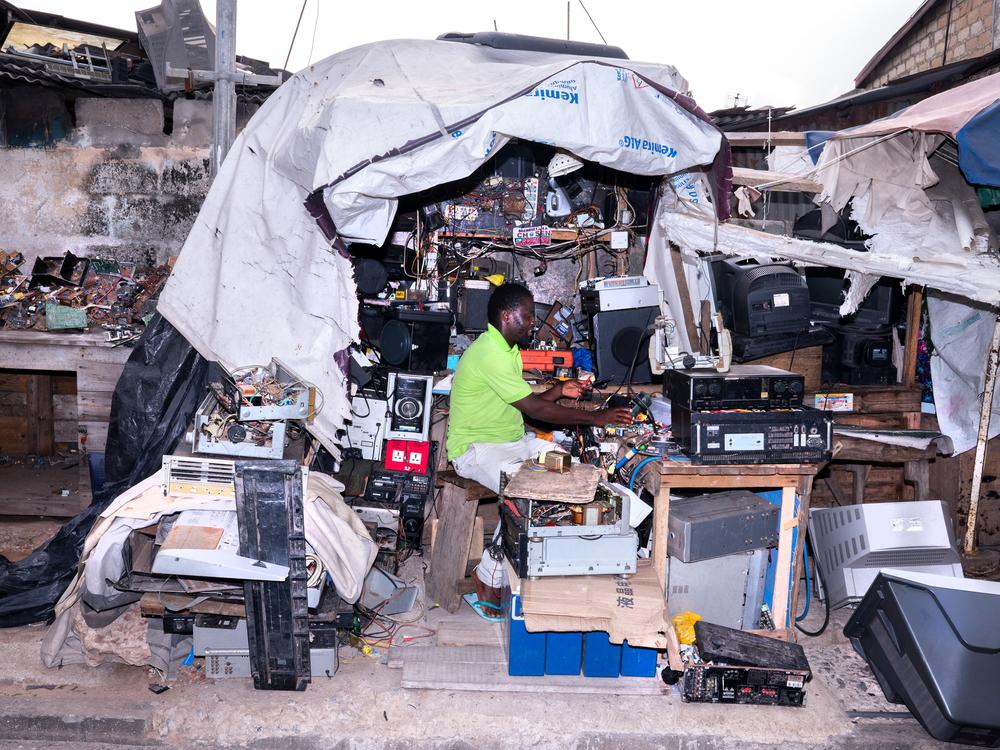Section Branding
Header Content
Stunning photos of a vast e-waste dumping ground — and those who make a living off it
Primary Content
When he was just 18 years old, Emmanuel Akatire traveled about 500 miles from his home in Zorko, Ghana, to Accra, the nation’s capital, to find the only work he could — sifting through vast piles of discarded electronics to find valuable scrap metal. A week’s worth of painstaking, often dangerous work, earns him the equivalent of about 60 U.S. dollars.
“I started doing scrap work around 2021 — after I lost both my parents — to provide for the rest of my family,” he told Muntaka Chasant, a photojournalist in Ghana. “There’s no electricity in my community, no development there,” he said. So he came to Accra, which has become a major dumping ground for the globe’s used electronics.
For years, a site called Agbogbloshie in Accra was one of the largest e-waste processing sites in Africa, getting 15,000 tons of discarded phones, computers and other used electronics each year. Many Western media outlets depicted the site as a public health and environmental tragedy, rife with toxic chemicals that leach into the water and poison the air. While that’s undoubtedly true, it’s not the full story, according to a new collaborative photojournalism project.
The project, called E-Waste in Ghana: Tracing Transboundary Flows, which won this year’s Fondation Carmignac photojournalism award, aims to capture both the positive and negative aspects of e-waste.
“The world cannot throw all its garbage here, it has truly negative consequences on the people,” says Anas Aremeyaw Anas, an investigative journalist in Ghana who co-led the project. “But there are positive aspects of sending us e-waste,” he says, as it’s sparked a dynamic, informal recycling economy in the country that, while often dangerous, can also help lift people like Emmanuel Akatire out of poverty.
Globally, e-waste is an enormous problem. In 2022, humans discarded about 62 million tons of used electronics, enough to fill a line of trucks that spans the equator. But there’s opportunity too, as those trucks contain over $91 billion of valuable metals, the U.N. estimates, though people like Akatire who do the dangerous recycling work reap the smallest share of those potential profits.
E-waste falls into two broad buckets: functional and non-functional. The line between them can be fuzzy, as what’s still usable or repairable to one person may not be to another, but the distinction is important. International laws prohibit trafficking of non-functional e-waste containing toxic substances, but the United Nations sees trading functional e-waste as beneficial, as it can lengthen the lifespan of a product.
The project found that exporters often fail to separate functional from non-functional e-waste. “If you have a container full of TV screens, how on earth are you going to verify each and every one of them to make sure that they are functioning,” says photojournalist Bénédicte Kurzen, a co-author of the project. As a result, both kinds of e-waste get stuffed into container ships that make their way to low- and middle-income countries like Ghana.
Formally, Ghana prohibits the import of many forms of hazardous e-waste material. But the team found that a well-placed bribe can get port officials to look the other way. As a result, informal e-waste sites are growing across Ghana’s coast. There, both functional and non-functional e-waste get dumped into vast piles that are encroaching on residential areas. Thousands of “pickers” come to these sites, picking through the rubbish to separate items that might be repaired from waste that could contain valuable minerals.
Many of the pickers are climate migrants from an area of Ghana known as the “Upper East,” says project co-author Chasant, where warming temperatures are upending traditional farming practices. “This area has the highest unemployment rate among young people,” he says. They come to e-waste sites to earn money during the dry season, Chasant says, which they bring back to the Upper East. “There’s a whole generation of young people that are building their society from e-waste work.”
It’s fraught, precarious work. To separate valuable minerals, like copper wire or iron, from useless plastic, pickers often burn the trash, producing noxious fumes. Burns, cuts and other injuries are common. E-waste workers — many of whom are children, the team found — are at risk of exposure to over 1,000 harmful chemicals, according to the World Health Organization, including lead, mercury and brominated flame retardants, which are linked to higher rates of diseases like cancer and diabetes.
Bernard Akanwee Atubawuna, a 21-year-old picker from Upper East, died while doing scrap work, says Chasant. His cause of death is unknown, but “Akanwee was a sickle-cell carrier and should never have been anywhere near fires/picking. But his parents said it was the only way he supported them. He sent his sister to learn a trade. He was also helping the parents to build a house back in the Upper East — all from picking.”
The harms extend beyond the dumps themselves. “There are many communities that have run to a halt as a result of the devastating effects of the poisonous gases that are inhaled,” says Anas. Heavy metals seep into the soil and water too, which can have profound health effects on local communities. “When people start burning, the poisonous fumes lead to people relocating.”
A burgeoning recycling and repair industry has risen up alongside those harms. The team documented informal marketplaces, where vendors sell scores of busted cell phones to buyers looking to repair circuit boards or extract their precious metals. On Zongo Lane in Accra, the reporters say, hundreds of small, independent shops sell used or repaired equipment, ranging from televisions to computers.
“In Africa, people still have this thing of repairing is important. Don't throw it away. You can still do things about it,” says Kurzen. In Western countries, people view these objects as much more disposable, she says, which is helping fuel the growth of e-waste worldwide.
The most valuable minerals extracted from Ghana’s e-waste often don’t stay in Ghana. Many of the most valuable items get cherry picked and sent to more advanced smelters in Europe or Asia, the team found. “People are dismantling these items in toxic environments, and then the few piles that contain incredibly valuable minerals are going to be re-exported,” says Kurzen.
She and her colleagues hope that the project prompts people to re-examine their relationship to the electronics in their lives. The few years we spend with a new phone represents just a blip in the story of the materials that power it, Kurzen says. “Those materials are traveling worldwide,” she says, “These [devices] we hold in our hands come at the expense of somebody, somewhere in the world. Nothing comes for free.”
Jonathan Lambert is a Washington, D.C.-based freelance journalist who covers science, health and policy.
Correction
A previous version of this story incorrectly stated that the Agbogbloshie scrapyard in Ghana received 250,000 tons of e-waste each year. That number refers to a 2011 estimate of the amount of e-waste received by five African countries. A study published in 2022 estimates Agbogbloshie received about 15,000 tons of e-waste per year.
